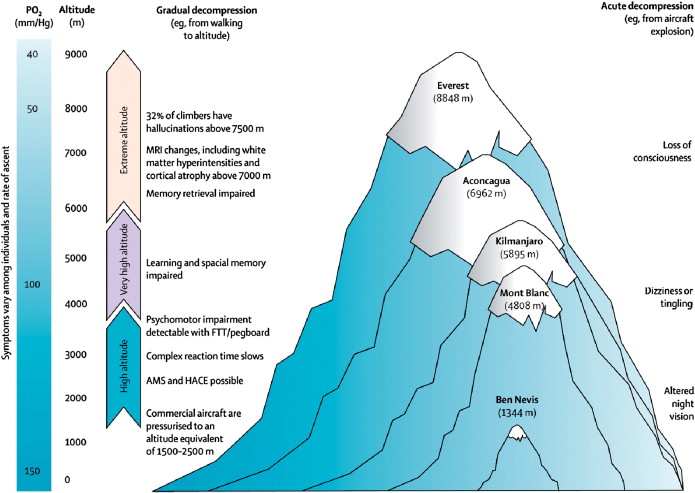Altitude Headache: Symptoms, Causes, Treatment
What are the symptoms of altitude headache?
Altitude headaches, also known as high-altitude headaches, are a common symptom of altitude sickness, which can occur when you travel to a high altitude too quickly. The symptoms of altitude headaches can vary but may include:
- Headache: A headache is the most common symptom of altitude sickness. It is often described as a throbbing headache that is usually located on both sides of the head.
- Nausea and vomiting: Some people with altitude headaches may also experience nausea and vomiting.
- Fatigue: Fatigue is another common symptom of altitude sickness, and it can contribute to the severity of headaches.
- Dizziness: Some people may feel dizzy or lightheaded at high altitudes, especially when standing up quickly.
- Loss of appetite: Altitude sickness can cause a loss of appetite, which can contribute to fatigue and other symptoms.
- Difficulty sleeping: Some people may have trouble sleeping at high altitudes, which can worsen headaches and other symptoms.
Altitude headaches typically occur within the first 12 to 24 hours after arrival at a high altitude and usually improve within a day or two as your body adjusts to the altitude. However, if you experience severe or persistent symptoms, such as confusion, difficulty walking, or chest pain, you should seek medical attention immediately, as these may be signs of a more serious form of altitude sickness.
What are the causes of altitude headache?
Altitude headaches, like other symptoms of altitude sickness, are caused by a lack of oxygen at high altitudes. When you travel to a high altitude, the air pressure is lower, which means there is less oxygen available in the air. This can lead to a condition called hypoxia, or low oxygen levels in the body, which can cause a variety of symptoms, including headaches.
The exact cause of altitude headaches is not fully understood, but it is believed to be related to the body’s response to the lower oxygen levels. One theory is that the blood vessels in the brain may dilate in an attempt to increase blood flow and oxygen delivery to the brain, which can cause pain and inflammation, leading to headaches. Additionally, changes in the levels of certain chemicals in the brain, such as serotonin, may also play a role in the development of altitude headaches.
Altitude headaches are more likely to occur when you travel to a high altitude too quickly, without giving your body enough time to acclimate. Other factors that can increase the risk of altitude headaches include dehydration, overexertion, and a history of migraines or other types of headaches.
What is the treatment for altitude headaches?
The best treatment for altitude headaches is to descend to a lower altitude where there is more oxygen. This can help relieve symptoms and allow your body to acclimate to the altitude more gradually. If descending is not immediately possible, or if your symptoms are mild, there are several other treatments that may help alleviate altitude headaches:
- Rest and hydration: Resting and staying hydrated can help alleviate symptoms of altitude sickness, including headaches. Drinking plenty of fluids can help prevent dehydration, which can worsen altitude sickness.
- Pain relievers: Over-the-counter pain relievers such as ibuprofen or acetaminophen can help relieve headache pain. However, it’s important to follow the dosing instructions carefully and avoid exceeding the recommended dose.
- Supplemental oxygen: In some cases, supplemental oxygen may be used to help alleviate symptoms of altitude sickness, including headaches. This may be administered through a portable oxygen tank or concentrator.
- Acclimatization: Gradual ascent to higher altitudes allows your body time to acclimate and can help prevent altitude sickness. If possible, plan your itinerary to include rest days at intermediate altitudes to allow your body to adjust.
- Avoid alcohol and caffeine: Alcohol and caffeine can contribute to dehydration, which can worsen altitude sickness. It’s best to avoid these substances while at high altitudes.
If your symptoms are severe or do not improve with these measures, it’s important to seek medical attention. Severe altitude sickness can be life-threatening and may require immediate descent to a lower altitude and medical treatment.
What Is an Altitude Headache?
An altitude headache, also known as acute mountain sickness (AMS) headache, is a type of headache that can occur when ascending to high altitudes, typically above 8,000 feet (2,438 meters).
The primary cause of altitude headaches is the decreased air pressure and lower oxygen levels at higher elevations. As the altitude increases, the air becomes “thinner,” containing less oxygen molecules per breath. This reduction in oxygen availability can lead to various physiological responses, including:
- Hypoxia (lack of adequate oxygen supply to the tissues)
- Increased breathing rate
- Mild dehydration due to increased respiratory water loss
- Mild swelling of brain tissues due to lack of oxygen
These changes can trigger a headache, which is often described as a constant, dull, or throbbing pain that worsens with exertion and may be accompanied by other symptoms of acute mountain sickness, such as:
- Nausea or vomiting
- Fatigue or weakness
- Dizziness or lightheadedness
- Insomnia
- Loss of appetite
Altitude headaches typically develop within 6 to 24 hours after reaching a high altitude and can range from mild to severe in intensity. The severity often correlates with the rate of ascent and the altitude achieved.
Risk factors for developing altitude headaches include:
- Rapid ascent to high altitudes without proper acclimatization
- Previous history of altitude sickness
- Strenuous physical activity at high altitudes
- Dehydration
- Respiratory or cardiovascular conditions
Proper acclimatization, rest, hydration, and medications (like acetaminophen, ibuprofen, or prescribed altitude sickness medications) can help alleviate altitude headaches. If symptoms persist or worsen, immediate descent to a lower altitude is recommended to prevent potentially life-threatening complications like high-altitude pulmonary edema (HAPE) or high-altitude cerebral edema (HACE).




